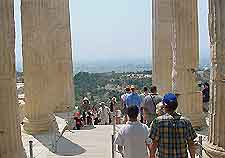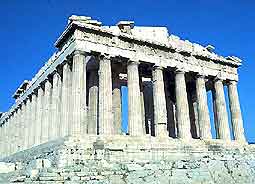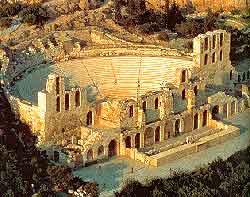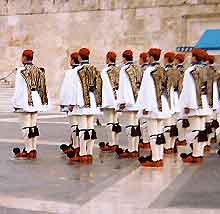Athens Landmarks and Monuments
(Athens, Attica, Greece)

The appeal of Athens really is all tied up in its ancient history and ruined landmarks, which certainly seem all the more impressive if you can use a little imagination to picture how they might once have appeared during their heyday, exuding grandeur and affluence.
Dedicated to the King of the Gods, the ancient ruined Temple of Olympian Zeus is one such structure and was constructed over a period spanning some eight centuries. The Acropolis of Athens forms another magnificent monument to the past and this giant flat-topped rock covers an area of more than 7.5 acres / 3 hectares, crowning the city from its elevated setting and being clearly visible from afar. Amongst the many remains of landmarks on the Acropolis, both the Parthenon and the Theatre of Dionysus Eleuthereus really do stand out from the crowd.
Sightseers in Athens may also like to check out Hadrian's Arch, the Ramnous Archaeological Site and the Hellenic Parliament building, where the Changing of the Guard ceremony each hour is worth looking out for, as is the heavily guarded Tomb of the Unknown Soldier.
Temple of Olympian Zeus
Address: Vassilissis Olgas Avenue, Athens 10557, Greece
Tel: +30 210 922 6330
Building of the Olympian Zeus Temple commenced in the 6th century BC, but the structure was not actually completed in its entirety until the 2nd century AD, when the reigning Roman emperor was Hadrian. However, the actual life span of the temple was surprisingly rather short, with it remaining abandoned just one century later, after a barbarian invasion. Following the demise of the Roman Empire, much of the temple was dismantled and used in the construction of buildings elsewhere, in rapidly expanding Athens. There were once more than 100 Corinthian columns making up this gigantic monument to Zeus, although today, only a handful remain, most of which are still standing at roughly 17 metres / 56 feet high.
Open hours: Tuesday to Sunday - 08:30 to 15:00

Athenian Acropolis (Akropolis)
Address: Dionysiou Areopagitou Street, Athens 10558, Greece
Tel: +30 210 32 14172
Both a world-famous landmark and an iconic symbol of the city, this natural phenomenon is topped by a series of classical Greek temples, known to have been built approximately 2,500 years ago. The most important of the archaeological remains on the Acropolis is without question the Parthenon, completed in 432 BC and dedicated to Athena, the Greek goddess of courage, inspiration and wisdom). The Parthenon remains in a surprisingly good state of repair, considering its age. Further significant Acropolis attractions include the Erechtheion Temple, the Odeon of Herodes Atticus, the Old Temple of Athena, the Sanctuary of Zeus Polieus, the Temple of Athena Nike and the Propylaea, which once served as a truly monumental gateway to the Acropolis, reached by a steep flight of stairs. Those planning to arrive by train will be pleased to learn that the Akropoli Station is relatively nearby.
Open hours: summer - 08:00 to 19:00, winter - 08:00 to sunset

Theatre of Dionysus Eleuthereus
Address: Plako, Athens, Greece
Tel: +30 210 321 0219
Located in central Athens and on the south-eastern side of the Acropolis, the remains of the Theatre of Dionysus Eleuthereus offer much more than a simple suggestion of the events that once took place here many centuries ago. Known to date back to the 5th century, this giant amphitheatre began its life as a more modest wooden structure, before being constructed in stone during the 6th century. It is estimated that the theatre would have been able to accommodate just under 20,000 cheering spectators, spread over more than 60 individual tiers, coming here to watch fighting events and more theatrical performances. Greek authorities have recently invested some $9 million to restore and preserve the Dionysos Theatre for future generations to appreciate.
Hadrian's Arch
Address: Amalias Avenue (off Vassilissis Olgas Avenue), Athens 10557, Greece
Measuring in at some 18 metres / 59 feet high by just over 13 metres / 43 feet wide, the famous Arch of Hadrian was constructed to function as the gate to the city, connecting Athens with the Roman quarters. The archway was built from marble during the early part of the 2nd century AD, in order to celebrate the arrival of renowned Roman Emperor Hadrian (76 to 138 AD). The neighbouring Temple of Olympian Zeus provides further interest, while the Akropoli metro station is close by.

Hellenic Parliament
Address: Syntagma Square, Athens 10671, Greece
Completed in the early 1840s and standing on Syntagma Square, the imposing Hellenic Parliament Building began its life as a royal palace. After suffering severe fire damage in 1909, the building underwent a lengthy period of reconstruction and renovation. During the early 1920s, the Greek monarchy was abolished and the building underwent a change of use, first becoming a hospital, and then a museum. In 1929, the government decreed that the former palace would become the official home of parliament, and whilst the monarchy was restored in 1935 (being later abolished again in 1973), this palatial landmark has remained as the Hellenic Parliament building ever since.
Ramnous
Address: Kato Souli, Marathon, Athens 19007, Greece
Tel: +30 294 63477
Located just over 35 km / 22 miles to the north-east of Athens and enjoying uninterrupted views across the Euboean Strait, the archaeological site of Ramnous comes with some very important preserved ruins, as well as two old harbours connecting the Aegean Sea. Recent excavations have uncovered many historical remains and relics from the burial sites. Visitors will find a number of important temples from the 5th and 6th century, particularly around the Sanctuary of Nemesis, along with various fortifications, remains of ancient walls and interconnecting pathways, appearing rather like a giant labyrinth.
Open hours: Tuesday to Sunday - 08:30 to 15:00
 The appeal of Athens really is all tied up in its ancient history and ruined landmarks, which certainly seem all the more impressive if you can use a little imagination to picture how they might once have appeared during their heyday, exuding grandeur and affluence.
The appeal of Athens really is all tied up in its ancient history and ruined landmarks, which certainly seem all the more impressive if you can use a little imagination to picture how they might once have appeared during their heyday, exuding grandeur and affluence.

